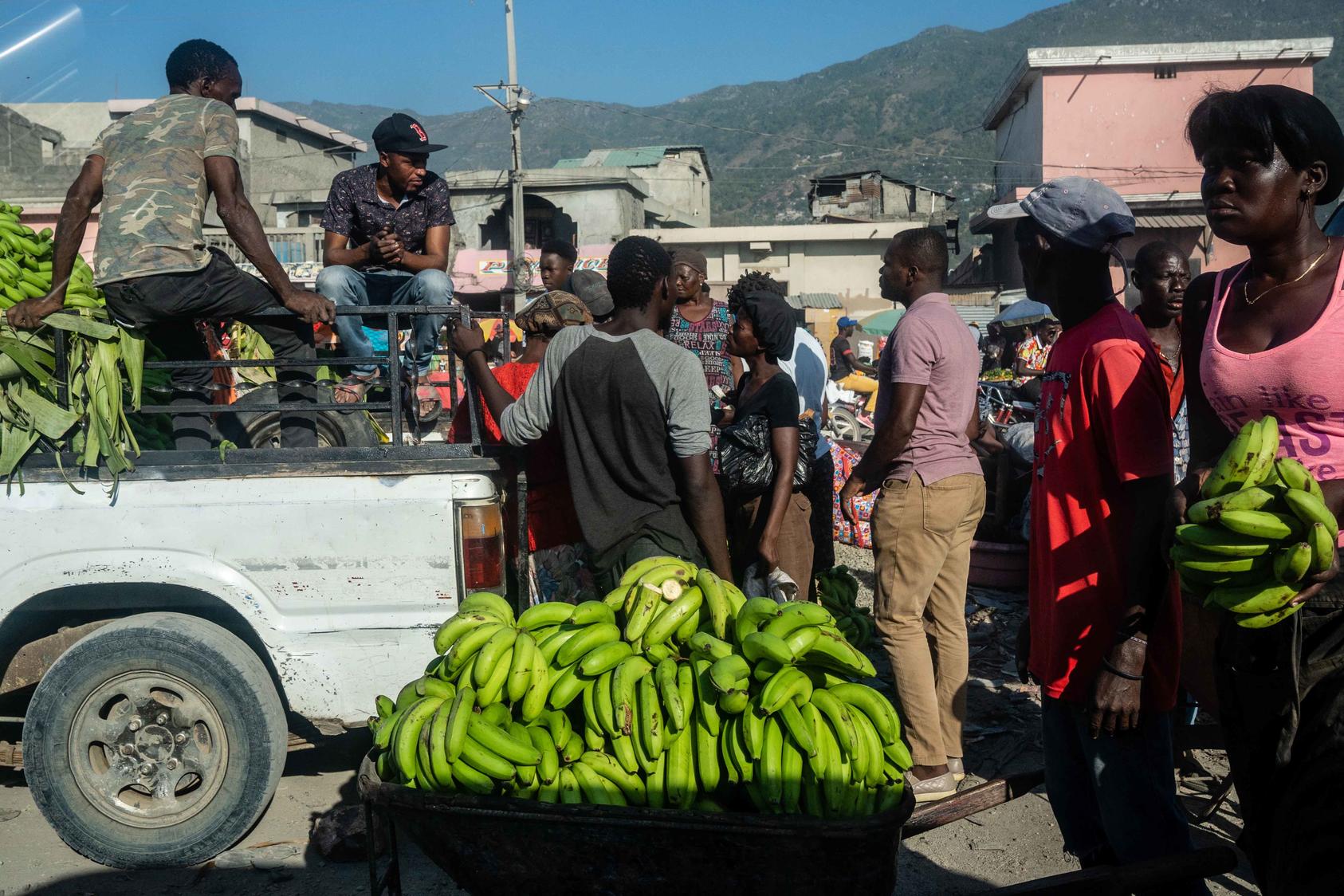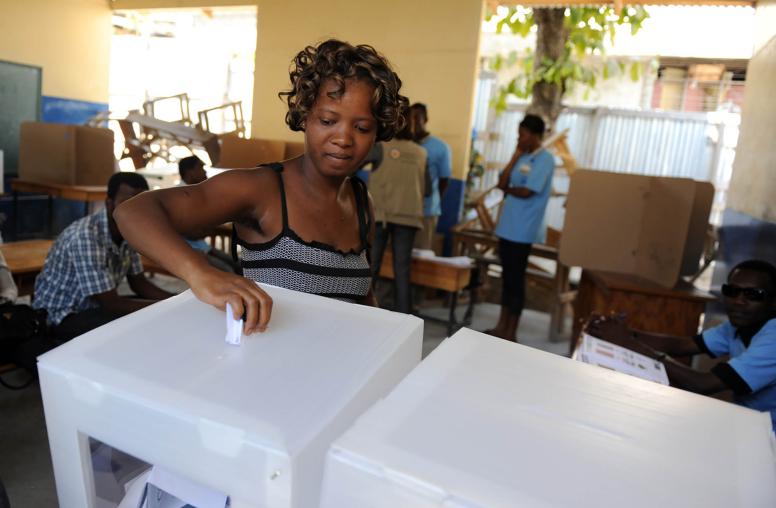Can A New U.S. Plan Finally Give Haiti the Long-Term Framework it Needs?
The Global Fragility Act approach could help stabilize the beleaguered nation, but only if it opens the door to true national inclusion.
Haiti represents the very definition of fragility. The country’s socioeconomic indicators are dire, with stresses on a battered economy reeling from COVID now exacerbated by fuel price spikes following Russia’s invasion of Ukraine and last year’s earthquake and tropical storm. The country’s health care system is in shambles. Gang violence restricts economic activity and instills fear. At its core, the economic and security collapse reflects a deep crisis of politics, where a staggering void of governance prevails. Given Haiti’s intersecting crises, the State Department’s announcement last week that the country would be designated as a priority under the Global Fragility Act is both welcome and logical.

Why Haiti?
The inclusion of Haiti as a priority country under the Global Fragility Act (GFA) — along with Libya, Mozambique, Papua New Guinea and a group of West African Coastal States — could finally provide a long-term policy framework for channeling U.S. assistance that has to date been erratic, focused on the short term and often ineffective.
The GFA represents a new approach to preventing conflict and promoting stability, focusing on a long-term, whole-of-government strategy. Following years of efforts that showed too little progress in advancing peace in fragile states — where the social contract between the state and citizens is weak or severed — the new strategy gives 10-year commitments of assistance within better coordinated strategies for economic and human development, and for conflict resolution. Relying heavily on recommendations developed by the USIP-convened Task Force on Extremism in Fragile States, the GFA looks to reorient efforts to prevent violence from an over-reliance on military operations to instead investing in the ability to prevent and mitigate violent conflict by addressing its underlying drivers.
To capitalize fully on this new framework, fresh assistance will need to start with supporting a process that allows all elements of Haitian civil society and political actors a voice in setting a national vision and governing. It is a tall order for a country as battered as Haiti, and the GFA does not provide all the answers, but for the first time the United States may at least be asking the right questions.
As just two examples of Haiti’s dire situation, among a host of the hemisphere’s worst indicators, some 60 percent of the already strained health facilities in the south have been destroyed and 62 percent of the country is experiencing food insecurity according to the U.N. There is little relief on the horizon, as the country’s infrastructure, especially the roads connecting the cities to airports, border crossings and other production hubs, are controlled by armed gangs who extort and kidnap travelers, while holding food and other essentials hostage. The gangs further restrict economic activity and instill fear throughout the country through kidnappings, which have increased almost 60 percent in the first three months of the year over 2021.
Since the assassination of President Jovenel Moïse in July 2021, acting President Ariel Henry has only marginal power in a traumatized executive branch, hamstrung by a judiciary and legislature that have all but broken down. Parliament was dissolved in 2020 after then-President Moïse failed to organize new elections and the judiciary is headless after Moïse removed three justices following accusations of an alleged coup plot in February 2021.
This daunting list of challenges is exactly what the GFA was intended for, and any other choice for the hemisphere would have reflected a policy of avoidance. It is bold to take on Haiti — but it is simply the right thing to do.
The GFA Provides a Fresh Start in a Long-Term Framework
The United States now promises through the GFA to implement two important changes to how it works with Haiti, providing a potential fresh start for a country that has received considerable assistance over the past decades with little fully cohering in stronger institutions and raised living standards.
First, the GFA calls for the development of a 10-year country strategy, designed along with Haitian partners, that will “look beyond urgent crises and near-term needs to focus on mutually determined strategic goals and interests.” This will allow for the integration and sequencing of U.S. diplomatic, development and military-related efforts toward the political goal of a lasting and resilient peace.
While this may sound routine, it actually would mark a sharp break in international engagement in Haiti to date, which has long suffered from a short-term vision and fleeting political support. U.N. peacekeeping missions, for example, have been subject to constant renewals, with the current U.N. Integrated Office on a six-month mandate, hampering the ability of the organization to plan and budget with any strategic vision.
The GFA approach, President Biden promised, will seek change “measured not in days and weeks, but in years and generations,” focusing on lasting peace and stability over the allure of easier, more temporary gains.
This language could easily have been written specifically for Haiti. There, the challenge is not just one of long-term issues that require a strategic vision, but the political dynamic itself, that in the view of Haiti expert Georges Fauriol, is distorted when international players act with a sense of expediency, their impatience driving a political process that simply requires time to play out.
In Partnership with an Inclusive Haitian Society
The second area where the GFA could make a material difference in Haiti is in its insistence that all elements of the U.S. government will work in close cooperation with a wide variety of local partners — including civil society organizations, community leaders, businesses and government officials — to arrive at a structured airing of all voices in shaping solutions, and by extension the inclusion of all of society in any political process. As President Biden said, these are the “closest and most vulnerable to these challenges and know best where the opportunities for peace and stability lie.”
Developing a fully inclusive political framework has been one of Haiti’s most persistent challenges. One of the chroniclers of the halting transition to democracy in the 1990s wrote of that time, “The next president will need to build support among all Haitians, not just a faction of fervent supporters.” Another questioned whether the international community was supporting democracy or merely supporting voting.
But including all societal voices was difficult then and it remains difficult now in a country so lacking in civil trust and with weak social organizations. Decades later, Georgetown professor Georges Fauriol wrote that in Haiti, the centralized national authority resides in a small urban constituency that is itself fractured. This “translates into a divisive feature of Haitian political dynamics, highlighted by the failure over the past decades to translate the promise of electoral democracy into sustainable and measurable outcomes … reinforcing for the average citizen … the exploitative character of elites.”
But Fauriol also points out that the past three decades have seen civil society grow into a diverse community of human rights organizations, local community interests, women’s groups, students and youth, labor unions and media “that have found some space to prosper.” The challenge, Fauriol offers, “lies in translating its significant civil society consensus into a convincing national governance structure.” This is no easy matter, but with the charge of the GFA to chart a long-term course that fully includes civil society, it has a much better chance of success than previous short-term efforts driven by a U.N. mandate and electoral calendar.
Conclusion
The late writer and observer Rufus Phillips has been a vocal and key proponent of the importance of stabilizing fragile states, and in that task the overriding importance of elevating the political over the military and developmental. In a book he finished just before his death, he suggests that no state stabilization strategy will succeed if it is not grounded ultimately in support for a government that generates, “through behavior and actions, a political cause worth sacrificing for, one that could earn the genuine support of the people.”
Analyst and professor Heather Selma Gregg writes similarly that the traditional approach of merely building institutions misses a critical, necessary component of a viable state: the attachment citizens feel toward one another and to their state. States, she wrote, “are not just structural, rational, utilitarian entities; they also provide a sense of identity, purpose and destiny among their own people. People need to identify with their country on a personal level, share its norms and believe in their common destiny … Rebuilding states … should include this sense of national unity.”
This is long-term work that requires the full mobilization of all elements of a society, something the GFA may now facilitate and without which any future efforts in Haiti are destined to fail.


